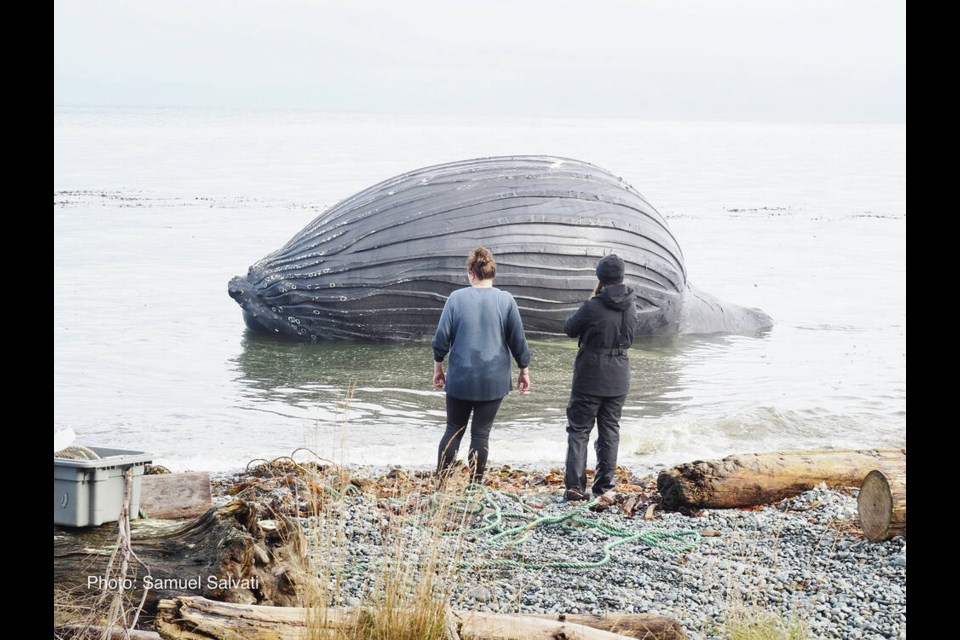Scientists are investigating the death of a juvenile humpback whale discovered off the north side of Malcolm Island.
The female whale has been identified as BCX1847, also known as Spike. First documented in 2018, the humpback has been seen in the area around Port Hardy and Port McNeill every year since, says Jackie Hildering of the Port McNeill-based Marine Education and Research Society.
The Department of Fisheries and Oceans and volunteers from the society helped to secure the severely bloated body to shore to ensure the animal and any evidence of its death didn’t wash away with the tides.
Malcolm Island residents Andrew and Lori Pinch discovered the dead whale on Sunday while walking their dog.
The cause of death isn’t immediately known. A necropsy scheduled for this week by Department of Fisheries and Oceans scientists is expected to determine circumstances around the whale’s death.
“Considering Spike was a young female and that there are no apparent external injuries, it will not be a surprise if it is found that she died from blunt force trauma from being hit by a boat,” said Hildering.
Hildering said the death serves as another warning to boaters. “Humpbacks are incredibly unpredictable — most don’t even know [a boat] is there,” she said. “They are hungry and feeding for their migrations … this is where the food is … and they are never going in a straight line.”
It all creates a “perfect storm” for a collision, she said.
The ‘Namgis First Nation will perform a cultural ceremony before the necropsy is undertaken.
Spike was nicknamed for a dinosaur-like marking on the left side of her fluke. Spike was a dinosaur character in the 1988 children’s animated movie The Land Before Time.
Hildering estimated the female to be seven or eight years old, but little is known about her lineage.
Humpback whales each have unique patterns on their flukes, similar to a human fingerprint, and are assigned alphanumeric titles and usually nicknames.
In the case of BCX1847, the BC indicates the whale was first identified by Fisheries and Oceans Canada in British Columbia, the X corresponds to the percentage of white skin on the flukes (X being 0% to 20% white), and the four-digit number represents the chronological order in which the whale was researched or discovered.
Nicknames can refer to patterns on the fluke, landmarks of locations where they were first spotted or a facet of their behaviour.
The Marine Education and Research Society has taken over the cataloging of humpback whales, with co-operation from the DFO. Researchers are adding other identifying markers, including unique patterns from inside their mouths and on dorsal fins, because the humpbacks don’t often show their tails.
The death of the humpback comes less than a week after a federal marine mammal rescue team successfully completed a dramatic rescue of a humpback entangled in fishing gear near Texada Island.
In drone video footage taken by the Department of Fisheries and Oceans, rescuers managed to release the gear, which appeared to be attached to the whale’s mouth.
Humpback whales are making a recovery in the Salish Sea, with 21 new calves born 2021, according to the Center for Whale Research based in Washington state.
Late summer and autumn are the peak of humpback activity, as the whales gorge on small fish and krill before travelling to warmer waters in Mexico, Central America and Hawaii to give birth and breed, then returning in late spring.
The Committee on the Status of Endangered Wildlife in Canada lists the humpback’s current status as “special concern,” elevated from “threatened” as the population rebounds from being reduced worldwide by as much as 95% because of whaling.
The most recent population estimate for the North Pacific humpback whale ranging the B.C. and Alaska coasts was 18,302 individuals, recovering at a rate of 4.9 to 6.8 percent annually. Despite this increase, scientists believe current numbers are still well below pre-whaling estimates.
Humpbacks in the North Pacific continue to face several threats, including noise disturbance, habitat degradation in breeding grounds like Mexico, ship strikes and entanglement in fishing gear or debris.
Anyone who sees a marine mammal in distress is asked to call the marine mammal incident reporting hotline at 1-800-465-4336.




